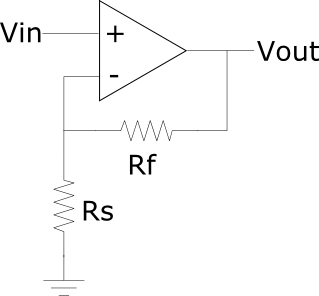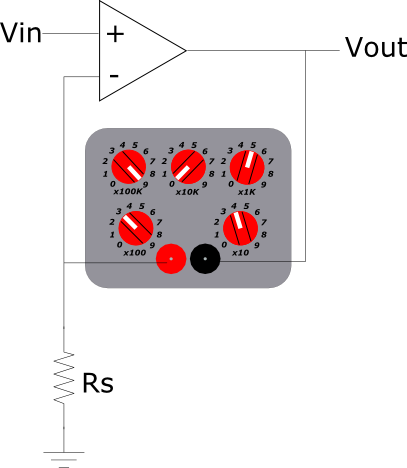Decade Resistance Box Hookup Guide
Experimental Circuit
Since portable digital instruments have mostly superseded traditional techniques like the Wheatstone bridge, lets explore a more practical application on the designer's workbench.
Variable Gain Amplifier
Sometimes, when we're interfacing an analog signal with a microcontroller, the analog voltage doesn't match the range of the analog-to-digital converter. For instance, the signal might swing 100 mV, but the converter is referenced to 5V - the converter would only use 2% of it's range.
To match the signal to the converter, we can build an amplifier circuit that boosts the incoming voltage. This circuit is known as a "conditioning amplifier" or "pre-amplifier" ("preamp" for short).
One simple preamp is an operational amplifier wired in non-inverting mode. The gain of the amplifier is configured with a pair of resistors.
The gain factor for the amplifier is
1+(Rf/Rs) For a given pair or resistors, we can calculate the gain factor - for example, if both are 10K Ω, the equation works out to
1+(10,000/10,000) Which simplifies to 2 - the output of the amplifier will be the input voltage multiplied by 2. To continue the example above, if 100mV go in, then 200 mV come out.
Sometimes when we start designing, we don't know the gain factor we need for an application. When building an amplifier to suit a specific application, it can be useful to have a preamp with adjustable gain. We can build one that uses a decade box for the feedback resistor, and selecting a shunt resistor that gives us a reasonable gain range.
With a decade box that goes to 999,990 Ω, and a 4.7K Ω resistor for the shunt, we can get a wide range of amplification, as shown in the following table.
| Arithmetic Gain | R1 (Shunt) | R2 (Feedback) |
| 1 | 4700 Ω | 0 |
| 1.212 | 4700 Ω | 1000 |
| 3.12 | 4700 Ω | 10,000 |
| 22.2 | 4700 Ω | 100,000 |
| 213 | 4700 Ω | 999,999 |
Once we have found the right resistor combination, we can remove the decade box, replacing it with a single resistor.
One thing to note with the non-inverting amplifier is that it can only increase the input, not reduce it (there's no way to select resistors that get rid of the 1 in the equation). The inverting amplifier also uses two resistors to configure gain, but can be configured for fractional (less than 1) gain, though this comes at the cost of other complexity. As the name states, this configuration inverts the signal at it's output - a situation that can be solved in software, but is also somewhat counter-intuitive.

